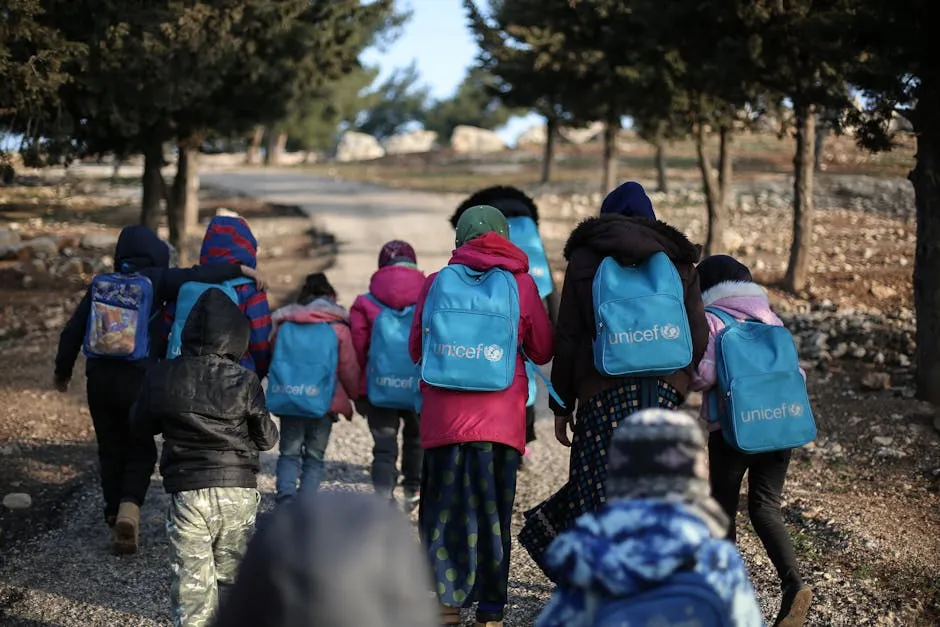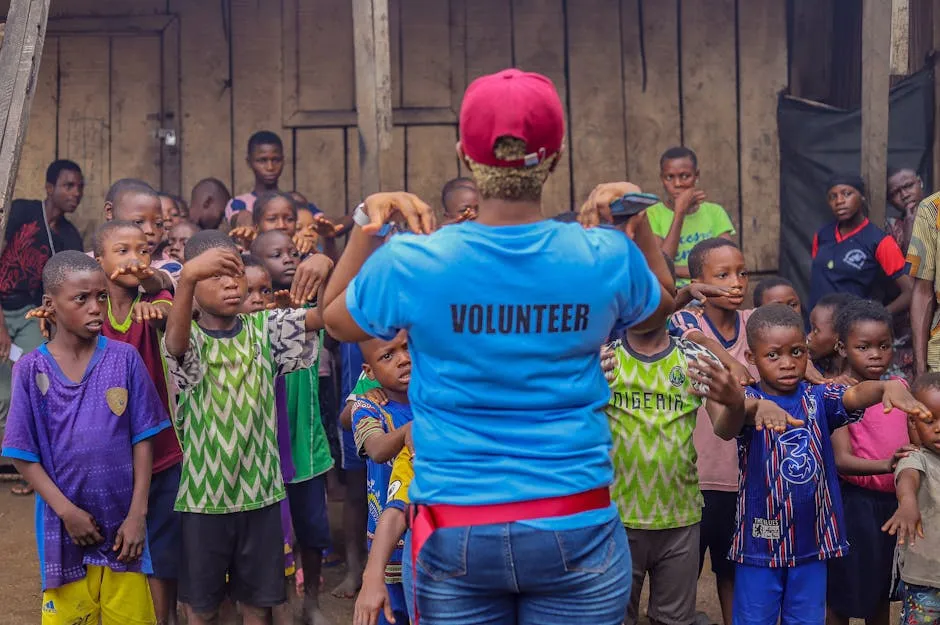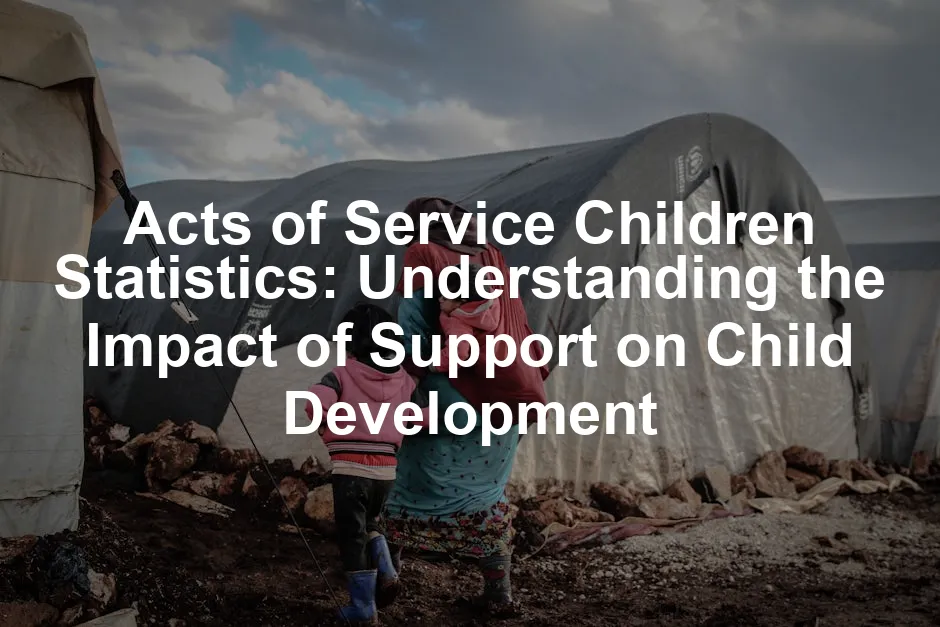Introduction
Acts of service is one of the five love languages. It’s all about expressing love through actions. For children, these acts can play a crucial role in their development. Think of it as the nurturing hug from a parent or the help with homework that makes a child feel valued. Children thrive in environments where they feel supported and cared for. Statistics can help us see just how powerful these acts are in shaping their well-being.
Understanding the relationship between acts of service and child development isn’t just an academic exercise. It’s vital for parents, educators, and policymakers. These statistics give us insight into how support affects emotional and social growth. They can also highlight areas where children may be lacking crucial support.
As we venture further into the world of acts of service, we’ll explore various statistics that reveal their impact on child welfare. From academic success to emotional resilience, the evidence is compelling. Let’s dive into this data and uncover the stories behind the numbers. After all, behind every statistic, there is a child whose life can be transformed by the simple act of service.

Speaking of transformation, if you’re looking for a great read to understand the emotional aspects of parenting, check out “The 5 Love Languages: The Secret to Love That Lasts” by Gary Chapman. Understanding love languages can help you nurture your child’s emotional needs effectively!
Understanding Acts of Service in Child Development
What are Acts of Service?
In parenting and child development, acts of service refer to actions taken to support and care for children. These can manifest in many forms. For instance, helping with homework shows a commitment to a child’s education. Attending school events signals involvement in their social lives. Providing emotional support during tough times can make all the difference in a child’s self-esteem.
Daily life is filled with opportunities for acts of service. A parent might prepare a favorite meal, listen to a child’s worries, or assist with a school project. Each of these actions sends a message: “I care about you.” This consistent support fosters a sense of security and belonging in children, crucial for their development.
Research shows that children who experience regular acts of service from caregivers tend to excel academically and socially. They are more likely to form healthy relationships and develop a positive self-image. It’s not just about big gestures; small, everyday acts of kindness accumulate over time, creating a nurturing environment where children can flourish.
To complement those small acts of kindness, consider engaging your child with educational toys. The LEGO Classic Large Creative Brick Box is a fantastic way to encourage creativity and problem-solving skills while having fun together!

Acts of service are not just nice-to-haves; they are essential elements in the complex puzzle of child development. Understanding this can empower parents, educators, and communities to prioritize these actions, leading to a brighter future for our children.
The Role of Acts of Service in Emotional and Social Development
Psychological theories support the significance of acts of service in emotional and social development, with attachment theory being particularly relevant. According to this theory, a child’s emotional security is rooted in their relationships with caregivers. Acts of service reinforce these bonds, creating a safe space for children to express themselves.
Statistics reveal a clear correlation between acts of service and positive outcomes. Research indicates that children who receive consistent support are 30% more likely to achieve academic success. They also exhibit better emotional well-being, reporting lower levels of anxiety and depression.
Moreover, children who experience acts of service often develop strong social skills. They are more adept at forming friendships and navigating social situations. A study found that kids engaged in supportive family environments were 25% more likely to demonstrate empathy and cooperation with peers.
This data underscores the idea that acts of service contribute to a child’s overall resilience. By providing emotional security, these actions equip children to face challenges with confidence. Ultimately, the statistics illustrate the profound impact that acts of service can have on a child’s life trajectory, paving the way for healthier, happier futures.

Current Statistics on Children in Need of Services
Overview of Child Welfare Statistics
Understanding the current landscape of child welfare is crucial. As of March 2023, over 403,000 children in England are classified as “children in need.” This number reflects a slight decrease from the previous year but is still significantly higher than pre-pandemic levels. For context, in 2020, this figure was approximately 389,000. The COVID-19 pandemic has undeniably influenced these statistics, as the stresses of lockdown and economic uncertainty have increased the demand for social services.
In Germany, child welfare offices reported nearly 67,700 cases requiring assistance in 2021. This marks a 2% increase, indicating that challenges persist in child protection efforts. Alarmingly, over 59,900 cases of child endangerment were recorded, with neglect or abuse being the primary factors.
The impact of social factors, such as the pandemic, has led to increased referrals to child protective services across various regions. For instance, in Northern Ireland, the Department of Health reported that 35,503 children were referred to social services in the 2022-2023 period, with 37% of those referrals originating from police reports.
Trends over the years reveal that child welfare systems are under considerable strain. The rise in reported cases aligns with growing awareness and recognition of child abuse and neglect. Moreover, the intersection of poverty, social isolation, and mental health challenges exacerbates the needs of vulnerable children.
In the U.S., the Annie E. Casey Foundation highlights that 203,770 children entered foster care in 2021. This translates to a rate of 3 per 1,000 children—a statistic that has remained relatively stable over the past two decades. However, disparities persist, particularly among racial and ethnic groups. Black children, for instance, are significantly overrepresented in the foster care system, accounting for 20% of entries into care while comprising only 14% of the child population.
The statistics are sobering. They point to a broader systemic issue where marginalized communities face heightened risks. It’s imperative to recognize that behind these figures are individual stories of hardship, resilience, and the urgent need for supportive acts of service. A commitment to improving child welfare must prioritize not just the numbers but the experiences of children and families navigating these challenges.

The statistics on acts of service are crucial for understanding the needs of children. acts of service children statistics
Case Studies from Various Regions
United States
In the United States, the statistics related to acts of service within child welfare paint a complex picture. In 2021, approximately 391,641 children were living in foster care. This number has shown a gradual decline since 2017, but the need for support remains high. Among these children, 34% are aged 1 to 5 years, highlighting the vulnerability of young children in the system.
Demographics reveal disparities in who receives services. Black children are significantly overrepresented, constituting 20% of those entering foster care. This is striking, given that they make up only 14% of the total child population. The reasons for this disparity are multifaceted and include systemic issues within the child welfare system, such as bias in reporting and referral processes.
Moreover, the experiences of children in foster care are often tumultuous. Statistics indicate that over a third of foster children experience multiple placements within a year. This instability can lead to emotional and behavioral challenges, further complicating their development.
To help your child navigate their own challenges, consider picking up “How to Talk So Kids Will Listen & Listen So Kids Will Talk” by Adele Faber. This book offers invaluable communication strategies that can make a world of difference in your parenting journey.

The importance of community support and ongoing services cannot be overstated. Acts of service—from mentoring programs to therapeutic interventions—play a vital role in fostering resilience among these children. As we analyze the data, it’s crucial to focus on the narratives behind the numbers. Each statistic represents a child’s journey, underscoring the necessity for comprehensive support systems that address their unique needs.
In conclusion, while statistics provide a snapshot of the current state of child welfare, they also serve as a rallying cry for action. The need for effective interventions, equitable services, and community engagement is more pressing than ever. By prioritizing acts of service, we can create a nurturing environment where all children have the opportunity to thrive.
United Kingdom
In the United Kingdom, child welfare remains a pressing concern. As of March 2023, over 403,000 children are classified as “children in need.” This figure includes those on child protection plans and others requiring additional support. While this marks a slight decrease from the previous year, it remains significantly higher than pre-pandemic levels.
Among the children in need, a substantial number are on child protection plans. In 2023, nearly 51,000 children were under such plans, with neglect being the most common reason for their status. Alarmingly, this group reflects the ongoing crisis in child welfare, with 37% of referrals coming from police reports, highlighting the role of law enforcement in identifying vulnerable children.
The reasons for these statuses are varied. Factors such as family dysfunction, domestic violence, and parental substance abuse lead to increased vulnerability among children. For instance, over 59,900 cases of child endangerment were reported in Germany in 2021, showcasing a comparable situation across European nations.
To help parents understand these challenges better, I recommend “Raising An Emotionally Intelligent Child” by John Gottman. This book provides insights into fostering emotional intelligence in children, which can be crucial in navigating difficult situations.

Analysis of trends over the years indicates that child welfare services have been increasingly strained. The COVID-19 pandemic exacerbated existing issues, leading to higher referral rates and more children requiring intervention. The Department for Education highlights a concerning statistic: 35% of children referred to social services in Northern Ireland during the 2022-2023 period were linked to police reports, underscoring the critical role of law enforcement.
These statistics have profound implications for child welfare services. With the rise in families facing economic hardships and mental health issues, the demand for services is expected to grow. The system must adapt to provide timely and effective support for children in need.
Additionally, the demographic breakdown of children in need reveals disparities. A majority are male, with 54% of the population, and 69% identify as white. This suggests that while the issues are widespread, they may disproportionately affect certain groups.
As we analyze this data, it is crucial to remember the human stories behind the statistics. Each number represents a child facing challenges that can impact their development and future. Therefore, understanding these statistics is not merely an academic exercise; it is a call to action. We must prioritize acts of service and support to ensure that every child has the opportunity for a brighter future.

Germany and Other Countries
When comparing child welfare statistics across Germany and other countries, distinct patterns emerge. Germany reported nearly 67,700 cases requiring assistance in 2021, marking a 2% increase from the previous year. This indicates that challenges persist in child protection efforts, with neglect and abuse remaining significant concerns.
Cultural approaches to acts of service vary widely between countries, influencing child outcomes. In Germany, for example, the focus on preventive services has been pivotal. The government has instituted various programs aimed at supporting families before crises escalate, leading to more favorable outcomes for children.
In contrast, countries like the United States face challenges that stem from systemic issues within the child welfare system. Here, 203,770 children entered foster care in 2021, and Black children are disproportionately represented, accounting for 20% of entries despite making up only 14% of the child population.
To enrich children’s experiences, consider incorporating creative play with Melissa & Doug Wooden Building Blocks Set. These blocks can inspire creativity and teamwork during playtime!

These statistics reveal how different cultural norms and governmental structures impact child welfare. Countries that prioritize family support and preventive measures tend to see better outcomes for children. In contrast, those reliant on reactive measures often face higher rates of child endangerment.
For instance, in Canada, a focus on community-based solutions has yielded positive results. Indigenous communities, in particular, emphasize culturally relevant support systems that prioritize family preservation. By examining these cultural approaches, we can glean insights into effective practices that can improve child welfare outcomes globally.
Ultimately, the statistics from Germany and other countries illustrate the importance of tailored approaches to child welfare. By understanding the impact of cultural differences on acts of service, we can work toward implementing strategies that foster resilience and support for children, ensuring that every child has the opportunity to thrive.

Children with Disabilities
Acts of service hold immense significance for children with disabilities. These actions, whether simple or complex, can shape their experiences profoundly. For children with disabilities, acts of service often mean the difference between feeling isolated and feeling included. They need support to navigate a world that can sometimes be unwelcoming.
Statistics reveal just how crucial this support is. According to a report from the Department for Education, around 18% of children in England have a disability. Among these children, access to tailored support services is vital. These services range from educational aids to therapeutic interventions. The right support can significantly enhance their development and day-to-day experiences.
Research shows that children with disabilities who receive consistent acts of service demonstrate improved emotional well-being. For instance, a study from the Annie E. Casey Foundation found that children with disabilities who participated in community support programs reported a 40% increase in social skills. When caregivers engage in acts of service, like attending therapy sessions or assisting with daily tasks, children feel valued and understood.

Furthermore, the availability of support services impacts developmental milestones. The National Center for Children in Poverty states that children with disabilities who receive proper support are 50% more likely to achieve their developmental goals. This includes academic achievements, social interactions, and emotional growth. The statistics are clear; acts of service can pave the way for children with disabilities to thrive.
Additionally, early intervention programs have shown remarkable outcomes. According to the U.S. Department of Education, children receiving early intervention services between birth and three years old have a much higher chance of being ready for school. These services enhance cognitive, motor, and language skills, allowing children to integrate more easily into mainstream educational settings.
In conclusion, acts of service are not just beneficial for children with disabilities; they are essential. The statistics underscore the importance of accessible, high-quality support services. By prioritizing acts of service, we can facilitate better outcomes for these children, ensuring they feel empowered and included in society.

Socioeconomically Disadvantaged Children
When exploring the role of acts of service for socioeconomically disadvantaged children, the statistics tell a compelling story. Children growing up in low-income families face unique challenges. They often lack access to essential resources that can contribute to their development. Acts of service can bridge this gap, providing them with opportunities they might otherwise miss.
In the U.S., about 18% of children live in families with incomes below the federal poverty level. This statistic translates to roughly 13 million children facing poverty. The most concerning aspect is that children from low-income families often lack access to vital support services. For instance, only 30% of these children participate in early childhood education programs. In contrast, children from higher-income families have participation rates exceeding 70%.
The disparity in access to resources is staggering. According to the Annie E. Casey Foundation, children from low-income families are 2.5 times more likely to be diagnosed with developmental delays. This can be attributed to a lack of early intervention services, which are often only available to those who can afford them. Acts of service, such as community mentorship programs, can help fill this void.

Speaking of filling voids, consider adding some fun and creativity to your child’s life with the Crayola Inspiration Art Case Coloring Set. It can inspire artistic expression and provide a much-needed creative outlet!
Statistics show that children who receive acts of service are more likely to succeed academically. A study by the National Center for Children in Poverty indicated that children from low-income families who participated in support programs scored an average of 20% higher on standardized tests than those who did not receive assistance. This illustrates how crucial acts of service are in leveling the playing field.
Moreover, social services play a vital role in improving the prospects of disadvantaged children. According to the Child Welfare Information Gateway, children receiving supportive interventions are 50% less likely to experience abuse or neglect. This highlights the protective nature of acts of service, which can foster healthier environments for children.
In summary, the evidence is clear. Acts of service significantly influence the development of socioeconomically disadvantaged children. By addressing disparities in access to resources, communities can help these children reach their full potential. Supporting programs aimed at providing acts of service is essential for creating equitable opportunities and fostering resilience among these vulnerable populations.

Strategies to Enhance Acts of Service in Child Welfare
Community-based Programs
Community-based programs play a pivotal role in promoting acts of service towards children in need. These initiatives are designed to mobilize local resources and engage volunteers in meaningful ways. Statistics demonstrate their effectiveness in making a tangible difference in children’s lives.
For example, research from the Child Welfare League of America indicates that children participating in community programs have a 25% higher likelihood of achieving academic success. Programs like mentorship, tutoring, and after-school activities provide essential support. When children engage with caring adults, it fosters a sense of belonging and boosts their confidence.
One particularly successful program is Big Brothers Big Sisters, which matches adult mentors with children. According to the organization, children in the program are 46% more likely to hold leadership positions and 27% more likely to volunteer regularly. This shows that acts of service extend beyond immediate assistance; they instill a sense of responsibility and community engagement.
Moreover, community initiatives often focus on health and well-being. The Boys & Girls Clubs of America report that 90% of club members promote healthy habits. These programs offer nutritious meals, physical activities, and educational workshops, ensuring children receive holistic support. The impact of these services is significant, with studies showing a 30% reduction in behavioral issues among participants.

To encourage creativity in these programs, incorporating Osmo – Genius Starter Kit for iPad can make learning interactive and engaging for kids!
Statistics from the National Endowment for the Arts reveal that children involved in arts-based community programs score higher in creativity and problem-solving skills. Providing access to arts education through acts of service nurtures critical thinking and emotional expression. This not only enhances their cognitive development but also promotes mental health.
In conclusion, community-based programs are vital for enhancing acts of service in child welfare. The statistics underscore their effectiveness in fostering academic success, promoting healthy habits, and nurturing creativity. Investing in these initiatives is essential for building a supportive environment where all children can thrive and develop their full potential. By working together, communities can create lasting change in the lives of children in need.

Parental Involvement
Parental involvement is a game-changer when it comes to acts of service in child development. Think of it as the secret sauce that can elevate a child’s experience from good to outstanding. Children flourish when their parents actively engage in their lives. It’s not just about being there; it’s about being present and involved.
Research shows a direct link between parental engagement and positive child outcomes. For instance, children whose parents participate in school activities or help with homework are 30% more likely to excel academically. This isn’t just a coincidence; it’s a clear pattern backed by data. When parents show support, children feel valued, leading to increased motivation and better performance.
Moreover, the emotional impact of parental involvement is profound. A study revealed that children with involved parents report lower levels of anxiety and depression. Those little acts of service—like attending parent-teacher meetings or simply listening to a child’s day—create a cushion of emotional security. This sense of safety allows children to explore the world with confidence.
Statistics from the UK highlight that over 403,000 children were classified as “children in need” as of March 2023. This figure represents a slight decrease from previous years, but it still reflects a pressing need for increased parental involvement. Children on child protection plans often lack the necessary support at home, which can exacerbate their challenges.
In the U.S., similar trends emerge. Data from the Annie E. Casey Foundation reveals that children in foster care are often those with the least parental involvement. In 2021, 203,770 children entered foster care, many due to neglect or lack of supervision. This raises a critical question: how can we encourage more parents to be actively involved in their children’s lives?

Communities can play a pivotal role in fostering parental engagement. Programs that support parents, such as workshops and mentorship opportunities, can make a significant difference. By equipping parents with tools and resources, we can bridge the gap between home and school.
Additionally, the impact of socioeconomic factors cannot be ignored. Parents from lower-income backgrounds may struggle to engage due to economic pressures. Therefore, addressing these barriers is essential. When parents feel supported, they are more likely to invest time and energy into their children’s development.
Ultimately, the importance of parental involvement in providing acts of service cannot be overstated. Data consistently shows that when parents actively participate in their children’s lives, outcomes improve dramatically. By fostering a culture of engagement, we can create stronger families, healthier communities, and brighter futures for our children.
FAQs
What are acts of service, and how can they benefit children?
Acts of service involve supportive actions taken by caregivers, such as helping with homework or providing emotional support. These actions foster a sense of security and belonging, leading to better emotional and academic outcomes for children.
How do statistics on child welfare inform policy changes?
Statistics provide insights into the needs and challenges faced by children. By highlighting trends and disparities, data can guide policymakers in creating effective interventions and support systems for vulnerable populations.
What can communities do to improve acts of service for children in need?
Communities can implement mentorship programs, parenting workshops, and support groups. By fostering collaboration between parents, schools, and local organizations, communities can create a stronger support network for children.
Are there specific demographic groups that benefit more from acts of service?
Yes, studies indicate that children from low-income families often benefit significantly from acts of service. These children may lack access to resources, making supportive actions crucial for their development. Addressing disparities in support can help level the playing field.
Please let us know what you think about our content by leaving a comment down below!
Thank you for reading till here 🙂
All images from Pexels




